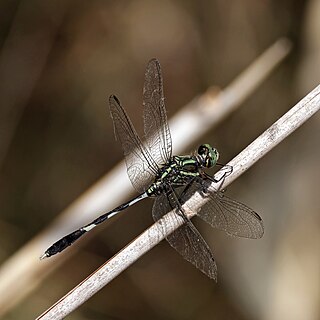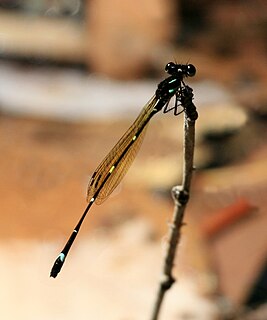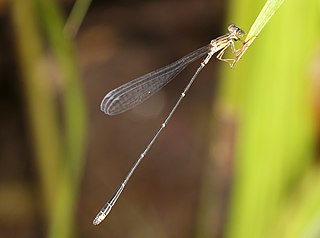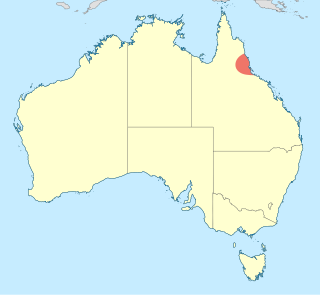
Damselflies are flying insects of the suborder Zygoptera in the order Odonata. They are similar to dragonflies, which constitute the other odonatan suborder, Anisoptera, but are smaller and have slimmer bodies. Most species fold the wings along the body when at rest, unlike dragonflies which hold the wings flat and away from the body. An ancient group, damselflies have existed since at least the Lower Permian, and are found on every continent except Antarctica.

Ischnura aurora, golden dartlet, also known as the aurora bluetail, is a species of damselfly in the family Coenagrionidae.

Orthetrum sabina, the slender skimmer or green marsh hawk, is a species of dragonfly in the family Libellulidae. It is widespread, being found from south-eastern Europe and North Africa to Japan and south to Australia and Micronesia.

Trithemis aurora, the crimson marsh glider, is a species of dragonfly in the family Libellulidae. It is a common and widely distributed species found throughout the year across the Indian subcontinent and Southeast Asia.

The blue riverdamsel, Pseudagrion microcephalum is a common species of damselfly in the family Coenagrionidae. It is also known as the blue sprite and blue grass dart.

The eastern billabongfly is a damselfly in the family Coenagrionidae. It is also known as the eastern dart. Eastern billabongflies are small damselflies about 25mm (1 inch) in length. They are found near slow running water or still water, such as lakes, ponds and ditches. Male and female eastern billabongflies mate in a wheel position.

The orange threadtail or ochre threadtail is an Australian damselfly in the family Platycnemididae. They are medium-sized with a length of around 35mm. Orange threadtails can be found near semi-shaded running water, and usually rest on plants at the water's edge. Orange threadtails may be seen all year round. In Victoria they occur at lower altitudes during summer, though further north they can be seen in spring and autumn. When at rest, Nososticta damselflies hold their wings closely folded up vertically over their thorax. The male threadtails have an orange-yellow thorax with black patterns. Their abdomen is narrow, black in colour with yellow strips. There is a brown yellow colour at the base of their wings. Females are the same size as the males. They are pale brown in colour and have the same black patterns as the males.

Austrolestes colensonis, commonly known as the blue damselfly, is a species of damselfly of the family Lestidae. It is endemic to New Zealand and can commonly be found throughout the country, and at any time of the year. It is New Zealand's largest damselfly, and only blue odonate.

Diphlebia coerulescens, known as the sapphire rockmaster, is an Australian species of broad winged damselfly. It is one of a group known as the azure damselflies. It is found in Queensland and north-eastern New South Wales in eastern Australia, where it is found in fast-flowing streams and rivers.

Agriocnemis pygmaea is a species of damselfly in the family Coenagrionidae. It is also known as wandering midget, pygmy dartlet or wandering wisp. It is well distributed across Asia and parts of Australia.

Nososticta solitaria is an Australian species of damselfly in the family Platycnemididae, commonly known as the fivespot threadtail. It is found only in north-eastern Australia.

Nososticta coelestina is an Australian species of damselfly in the family Platycnemididae, commonly known as the green-blue threadtail.

Rhadinosticta banksi is an Australian species of damselfly in the family Isostictidae, commonly known as the northern wiretail.

Ischnura pruinescens is a damselfly in the family Coenagrionidae, commonly known as the colourful bluetail. The taxon has been assessed for the IUCN Red List as being of least concern and is listed in the Catalogue of Life.

Austrothemis nigrescens is a species of dragonfly of the family Libellulidae, commonly known as the swamp flat-tail. It is endemic to southern Australia, where it inhabits lakes and swamps. It is a small dragonfly; the male has a flattened abdomen with black and red markings, and the female has black and yellow markings.

Euphaea dispar, Nilgiri torrent dart, is a species of damselfly in the family Euphaeidae.

Oristicta filicicola is a species of damselfly belonging to the family Isostictidae. Until 2017 it was the only species of the genus Oristicta. Commonly known as a slender wiretail, it is a slender and dull-coloured damselfly of medium-size. It is endemic to north-eastern Australia, where it inhabits streams in rainforests.

Griseargiolestes griseus is a species of Australian damselfly in the family Megapodagrionidae, commonly known as a grey flatwing. It is endemic to south-eastern New South Wales, where it inhabits bogs and seepages near small streams.

Griseargiolestes metallicus is a species of Australian damselfly in the family Megapodagrionidae, commonly known as a metallic flatwing. It has only been recorded from rainforests in the vicinity of Tully Gorge National Park in northern Queensland, where it inhabits streams.
Sinolestes is a genus of damselfly in the family Synlestidae. It is monotypic, the sole species being Sinolestes editus. It is found in southeastern China, Taiwan, and probably northern Vietnam.






















